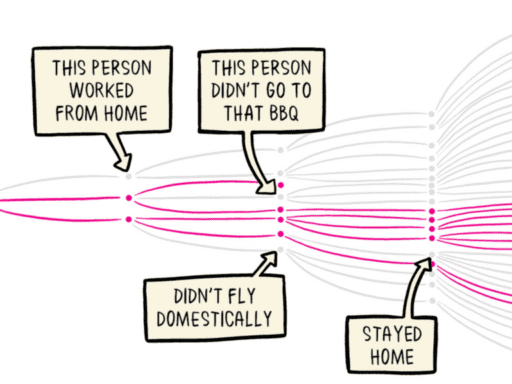“It’s not about you, it’s about everybody else.”
If you think you don’t have a huge role to play in how the coronavirus outbreak plays out, think again. You have the potential to make this pandemic so much worse.
That’s because the coronavirus is both more contagious and more deadly than the common flu. One person can easily transmit it to other people without knowing it, and those people would then transmit it to even more people, creating a terrifying snowball effect.
The good news is, just as you can easily transmit the virus to other people, you can easily avoid transmitting it — if you’re willing to stay home. That’s right: Simply by sitting on your couch, you can potentially save lives.
To see why, check out the visualization below. It shows how one person with the coronavirus, who passes on the virus to three other people (some experts say three is the average, though others estimate the infectiousness is a bit lower), can very quickly spawn a public health nightmare that afflicts thousands of people. But it also shows how one person can mitigate that effect through social distancing. By avoiding the office, the barbecue, the airport, and so on, an individual can deprive the virus of the opportunity to infect more people.
/cdn.vox-cdn.com/uploads/chorus_asset/file/19832101/Covid_19_Transmission_graphic_01.gif)
One striking real-world example of this phenomenon is the woman known as Patient 31. South Korea had only 30 cases of Covid-19 until, in February, she became infected and started inadvertently spreading the virus. Despite having a fever, she had lunch with a friend at a hotel and attended church services, coming into physical contact with many of the worshippers. In a matter of days, hundreds of people from the church and its environs tested positive for Covid-19.
You do not want to be Patient 31.
This is why even if you’re young and healthy and falsely believe the virus can’t kill you (it can), you’d do well to stay home in order to protect others — especially older and immunocompromised people who are at greater risk of dying if they contract Covid-19, as well as the health care workers who have to expose themselves to the risk every day.
Breaking down the math of infection
Believe it or not, through the simple act of staying home, you can save many people — even many thousands of people — from contracting the virus.
Hugh Montgomery, director of the Institute for Human Health and Performance at University College London, broke down the math in an incredibly clear and simple video.
This is the best and clearest explanation of why people need to stay at home you could ever wish to see pic.twitter.com/49MgadlctI
— Alan White (@aljwhite) March 22, 2020
To figure out just how infectious a disease is, experts use the basic reproduction number, called the R0 (pronounced “R naught”). That refers to how many other people one sick person will infect on average in a group that doesn’t already have immunity. The higher the R0, the higher the likelihood that many people will get sick.
The R0 for the common flu is 1.3. So, if you get the flu, you will, on average, pass that on to 1.3 people. Montgomery calculates that if each of those 1.3 people pass it on to another 1.3 people, and that keeps on happening 10 times, then by the 10th time, 14 people will have the flu.
(That’s because 1.3 to the power of 10 is 13.786. He’s rounding up a bit.)
The coronavirus, however, is more contagious than the common flu. Experts are still trying to figure out the R0, and in any case it’s not something that’s precisely fixed, since diseases behave differently in different environments and some people (known as “super-spreaders”) are more contagious than others. But the World Health Organization says most estimates of the coronavirus’s R0 are around 2 or 2.5, while some estimates put it as high as 3.11. Montgomery uses an R0 of 3 to make his calculations.
“So every person passes to it three — now that doesn’t sound like much of a difference, but if each of those three pass it to three and that happens in 10 layers, I have been responsible for infecting 59,000 people,” he says.
(That’s because 3 to the power of ten is 59,049. He’s rounding down a bit.)
Montgomery’s back-of-the-envelope math simplifies reality a little; for example, he assumes that all the people in all 10 layers of transmission will be susceptible to contracting the virus, whereas some might already have immunity to it. But his basic point holds up.
And the conclusion he draws at the end is crucial: “If you are irresponsible enough to think that you don’t mind if you get the flu, remember it’s not about you — it’s about everybody else.”
Although it can be genuinely hard to act altruistically when the beneficiaries are so invisible — after all, you won’t be able to see the grandfather or nurse you’ve kept from getting sick — please know that the benefits are real nonetheless.
Every day that you practice social distancing during the pandemic, you’re doing someone else (maybe hundreds or even thousands of someone elses) a great kindness. So if you can, stay home. It’s the easiest act of heroism you’ll ever do.
Sign up for the Future Perfect newsletter and we’ll send you a roundup of ideas and solutions for tackling the world’s biggest challenges — and how to get better at doing good.
Future Perfect is funded in part by individual contributions, grants, and sponsorships. Learn more here.
Author: Sigal Samuel
Read More



